The global market for Preimplantation Genetic Diagnosis (PGD) was valued at US$120.4 Million in 2024 and is projected to reach US$160.4 Million by 2030, growing at a CAGR of 4.9% from 2024 to 2030. This comprehensive report provides an in-depth analysis of market trends, drivers, and forecasts, helping you make informed business decisions. The report includes the most recent global tariff developments and how they impact the Preimplantation Genetic Diagnosis (PGD) market.
Segments: Segment (Chromosomal Abnormalities, Aneuploidy, X-linked Diseases, Single Gene Disorders, HLA Typing, Gender selection, Other PGD Tests).
Geographic Regions/Countries: World; United States; Canada; Japan; China; Europe (France; Germany; Italy; United Kingdom; Spain; Russia; and Rest of Europe); Asia-Pacific (Australia; India; South Korea; and Rest of Asia-Pacific); Latin America (Argentina; Brazil; Mexico; and Rest of Latin America); Middle East (Iran; Israel; Saudi Arabia; United Arab Emirates; and Rest of Middle East); and Africa.
The analysts continuously track trade developments worldwide, drawing insights from leading global economists and over 200 industry and policy institutions, including think tanks, trade organizations, and national economic advisory bodies. This intelligence is integrated into forecasting models to provide timely, data-driven analysis of emerging risks and opportunities.
Global Preimplantation Genetic Diagnosis (PGD) Market - Key Trends and Drivers Summarized
Preimplantation Genetic Diagnosis (PGD): Safeguarding Genetic Health
Preimplantation genetic diagnosis (PGD) is a specialized procedure used in conjunction with in vitro fertilization (IVF) to screen embryos for genetic abnormalities before they are implanted in the uterus. This technique allows couples with a history of genetic disorders or chromosomal abnormalities to reduce the risk of passing these conditions on to their offspring. PGD involves the biopsy of one or more cells from a developing embryo, typically on the third or fifth day after fertilization, followed by genetic analysis to detect specific mutations or chromosomal abnormalities. Only embryos that are free of genetic defects are selected for implantation, increasing the likelihood of a healthy pregnancy and reducing the risk of genetic diseases. PGD is particularly valuable for couples who are carriers of hereditary conditions such as cystic fibrosis, Huntington's disease, or sickle cell anemia, as it provides an additional layer of assurance in the reproductive process.How Are Technological Advancements Enhancing Preimplantation Genetic Diagnosis (PGD)?
Technological advancements have significantly improved the accuracy, reliability, and scope of preimplantation genetic diagnosis (PGD). The advent of next-generation sequencing (NGS) has revolutionized PGD by allowing comprehensive analysis of the entire genome, enabling the detection of a broader range of genetic abnormalities with greater precision. This technology has also reduced the time required for genetic analysis, allowing for faster decision-making in the IVF process. The development of more sophisticated biopsy techniques, such as trophectoderm biopsy on day five embryos, has increased the safety and effectiveness of PGD, minimizing the risk of harm to the embryo while providing a larger and more representative sample for analysis. Additionally, advances in bioinformatics and data analysis have enhanced the interpretation of genetic data, providing more accurate and detailed insights into the genetic health of embryos. These technological improvements have expanded the applications of PGD, making it a more powerful tool for ensuring the genetic health of future generations.What Are the Key Applications and Benefits of Preimplantation Genetic Diagnosis (PGD)?
Preimplantation genetic diagnosis (PGD) is used in various reproductive scenarios, offering numerous benefits that enhance the likelihood of a healthy pregnancy and reduce the risk of genetic disorders. In cases where one or both parents are carriers of a known genetic mutation, PGD allows for the selection of embryos that do not carry the mutation, significantly reducing the risk of passing the condition on to the child. PGD is also used in cases of recurrent pregnancy loss, where it helps identify embryos with chromosomal abnormalities that are less likely to result in a successful pregnancy. Additionally, PGD is valuable for older women undergoing IVF, as it can screen for age-related chromosomal abnormalities, such as Down syndrome, improving the chances of a healthy pregnancy. The primary benefits of PGD include its ability to reduce the risk of genetic diseases, increase the success rate of IVF, and provide peace of mind to prospective parents. By allowing for the selection of genetically healthy embryos, PGD enhances the reproductive process and contributes to the long-term health of future generations.What Factors Are Driving the Growth in the Preimplantation Genetic Diagnosis (PGD) Market?
The growth in the preimplantation genetic diagnosis (PGD) market is driven by several factors. The increasing prevalence of genetic disorders and the growing awareness of the benefits of genetic screening in reproductive health are significant drivers. Technological advancements that improve the accuracy, safety, and accessibility of PGD are also propelling market growth. The rising demand for IVF procedures, particularly among older women and couples with a history of genetic disorders, is further boosting the adoption of PGD. Additionally, the expansion of genetic counseling services, which guide couples through the PGD process, is contributing to market growth. The increasing availability of advanced genetic testing technologies and the growing focus on personalized medicine are further driving the market. These factors, combined with the continuous innovation in reproductive genetics, are driving the sustained growth of the PGD market.Report Scope
The report analyzes the Preimplantation Genetic Diagnosis (PGD) market, presented in terms of units. The analysis covers the key segments and geographic regions outlined below.Segments: Segment (Chromosomal Abnormalities, Aneuploidy, X-linked Diseases, Single Gene Disorders, HLA Typing, Gender selection, Other PGD Tests).
Geographic Regions/Countries: World; United States; Canada; Japan; China; Europe (France; Germany; Italy; United Kingdom; Spain; Russia; and Rest of Europe); Asia-Pacific (Australia; India; South Korea; and Rest of Asia-Pacific); Latin America (Argentina; Brazil; Mexico; and Rest of Latin America); Middle East (Iran; Israel; Saudi Arabia; United Arab Emirates; and Rest of Middle East); and Africa.
Key Insights:
- Market Growth: Understand the significant growth trajectory of the Chromosomal Abnormalities segment, which is expected to reach US$33.6 Million by 2030 with a CAGR of a 4.2%. The Aneuploidy segment is also set to grow at 4.6% CAGR over the analysis period.
- Regional Analysis: Gain insights into the U.S. market, valued at $31.7 Million in 2024, and China, forecasted to grow at an impressive 7.2% CAGR to reach $34.6 Million by 2030. Discover growth trends in other key regions, including Japan, Canada, Germany, and the Asia-Pacific.
Why You Should Buy This Report:
- Detailed Market Analysis: Access a thorough analysis of the Global Preimplantation Genetic Diagnosis (PGD) Market, covering all major geographic regions and market segments.
- Competitive Insights: Get an overview of the competitive landscape, including the market presence of major players across different geographies.
- Future Trends and Drivers: Understand the key trends and drivers shaping the future of the Global Preimplantation Genetic Diagnosis (PGD) Market.
- Actionable Insights: Benefit from actionable insights that can help you identify new revenue opportunities and make strategic business decisions.
Key Questions Answered:
- How is the Global Preimplantation Genetic Diagnosis (PGD) Market expected to evolve by 2030?
- What are the main drivers and restraints affecting the market?
- Which market segments will grow the most over the forecast period?
- How will market shares for different regions and segments change by 2030?
- Who are the leading players in the market, and what are their prospects?
Report Features:
- Comprehensive Market Data: Independent analysis of annual sales and market forecasts in US$ Million from 2024 to 2030.
- In-Depth Regional Analysis: Detailed insights into key markets, including the U.S., China, Japan, Canada, Europe, Asia-Pacific, Latin America, Middle East, and Africa.
- Company Profiles: Coverage of players such as Abbott Laboratories, F. Hoffmann-La Roche AG, Illumina, Inc., Laboratory Corporation of America Holdings (LabCorp), Natera, Inc. and more.
- Complimentary Updates: Receive free report updates for one year to keep you informed of the latest market developments.
Some of the 46 companies featured in this Preimplantation Genetic Diagnosis (PGD) market report include:
- Abbott Laboratories
- F. Hoffmann-La Roche AG
- Illumina, Inc.
- Laboratory Corporation of America Holdings (LabCorp)
- Natera, Inc.
- PerkinElmer, Inc.
Tariff Impact Analysis: Key Insights for 2025
Global tariff negotiations across 180+ countries are reshaping supply chains, costs, and competitiveness. This report reflects the latest developments as of April 2025 and incorporates forward-looking insights into the market outlook.The analysts continuously track trade developments worldwide, drawing insights from leading global economists and over 200 industry and policy institutions, including think tanks, trade organizations, and national economic advisory bodies. This intelligence is integrated into forecasting models to provide timely, data-driven analysis of emerging risks and opportunities.
What’s Included in This Edition:
- Tariff-adjusted market forecasts by region and segment
- Analysis of cost and supply chain implications by sourcing and trade exposure
- Strategic insights into geographic shifts
Buyers receive a free July 2025 update with:
- Finalized tariff impacts and new trade agreement effects
- Updated projections reflecting global sourcing and cost shifts
- Expanded country-specific coverage across the industry
Table of Contents
I. METHODOLOGYII. EXECUTIVE SUMMARY2. FOCUS ON SELECT PLAYERSIII. MARKET ANALYSISIV. COMPETITION
1. MARKET OVERVIEW
3. MARKET TRENDS & DRIVERS
4. GLOBAL MARKET PERSPECTIVE
UNITED STATES
CANADA
JAPAN
CHINA
EUROPE
FRANCE
GERMANY
ITALY
UNITED KINGDOM
SPAIN
RUSSIA
REST OF EUROPE
ASIA-PACIFIC
AUSTRALIA
INDIA
SOUTH KOREA
REST OF ASIA-PACIFIC
LATIN AMERICA
ARGENTINA
BRAZIL
MEXICO
REST OF LATIN AMERICA
MIDDLE EAST
IRAN
ISRAEL
SAUDI ARABIA
UNITED ARAB EMIRATES
REST OF MIDDLE EAST
AFRICA
Companies Mentioned (Partial List)
A selection of companies mentioned in this report includes, but is not limited to:
- Abbott Laboratories
- F. Hoffmann-La Roche AG
- Illumina, Inc.
- Laboratory Corporation of America Holdings (LabCorp)
- Natera, Inc.
- PerkinElmer, Inc.
Table Information
| Report Attribute | Details |
|---|---|
| No. of Pages | 173 |
| Published | April 2025 |
| Forecast Period | 2024 - 2030 |
| Estimated Market Value ( USD | $ 120.4 Million |
| Forecasted Market Value ( USD | $ 160.4 Million |
| Compound Annual Growth Rate | 4.9% |
| Regions Covered | Global |









